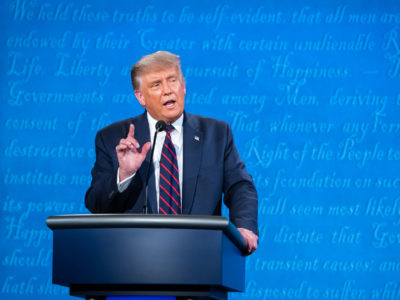Trump Confused Clean Air and Climate Change

President Trump at Debate 9-29-20 with Joe Bidden (Image CC Adam Schultz)
“What do you believe about the science of climate change? And what will you do in the next four years to confront it?”
asked Moderator Chris Wallace, directing the question to President Trump in the first 2020 Presidential debate. The President replied:
“I want crystal clean water and air. I want beautiful clean air. We have now the lowest carbon, if you look at our numbers right now, we are doing phenomenally.”
The President may have done that as a deflection, but it’s also very possible that he’s confused between climate change and clean air. To be fair, former Vice President Biden could have used his turn to point out the President’s confusion, but did not. From my work, I know that a large portion of the public confuses the two issues.
Before I proceed, I should advise any new readers that I purposefully avoid taking sides politically in my messages about sea level rise and climate change. While that frustrates some, I have held that non-partisan policy since I began this blog post in 2010 and started to write my book, “High Tide on Main Street: Rising Sea Level and the Coming Coastal Crisis.” Though I definitely have a position and do vote, I chose political neutrality in my work, in order to have as wide an audience as possible with this message that should be non-partisan.
Back to the issue up for policy debate, what are we going to do about climate change? Climate change is being primarily driven by the increase of “greenhouse gases” that act as insulation and warm the planet. Carbon dioxide (CO2) is the greenhouse gas of greatest concern. It’s the by-product of burning fossil fuels and now 40% higher than in millions of years. Carbon dioxide is 100% clear. It’s the “fizz” in carbonated beverages. The clear molecular compound combines one carbon atom and two oxygen atoms, In sharp contrast, carbon is normally pure black, seen in dark smoke, soot, graphite and the primary component of black coal. Carbon is a significant part of visible air “pollution.” Since the dawn of the industrial era, we have produced dark smoke, that is visible in the air as soot or smog, and can cause respiratory illness. There are many contributors to air pollution besides carbon, including nitrogen oxides, sulfur oxides, etc. Starting a half century ago, under the U.S. Clean Air Act of 1970, great efforts were made to clear the air of those forms of harmful pollution, with considerable success.
In the late 1980’s when climate change became a widely understood concern, efforts began to measure and reduce the clear carbon dioxide. Rather than push through new legislation dealing with the new threat of carbon dioxide, for expediency, it was designated as a “pollutant” and therefore subject to the existing Clean Air Act and the EPA. That legal concept was challenged by the fossil fuel industry and allies, becoming a battle that went to the Supreme Court. The court held that because CO2 was now harmful to the world it could be considered a pollutant, despite the fact it was a natural part of the plant and animal kingdoms. It was that mingling of dirty air that was obviously a pollutant, with the warming effect of clear carbon dioxide also referred to as a pollutant that set the stage for the confusion that continues today.
Then the confusion was made even worse because the environmental and scientific communities started using “carbon” as a shorthand for carbon dioxide. “Carbon footprints” and taking the carbon out of the air, became the lingo and jargon, to show that one knew about carbon dioxide. In terms of communication with the public, it was a terrible move. All of that brings us to the current situation, where many people are confused by the interchange of clean air and climate change, as demonstrated last week.
If we are going to support effective policies, and elect leaders who share our priorities, we need to communicate and have the same agenda. We need clean air, and we need to reduce the invisible greenhouse gases. BTW there is a third issue that adds to this confusion, the hole in the ozone, quite separate from the other two. To deal with the crisis of climate change or global warming, we need to apply the right solutions to the right problem. The first requirement is the right terminology to keep the discussion on topic. Clean air and climate change are separate issues. Carbon is not carbon dioxide. For those wanting a little deeper explanation distinguishing these three issues, my blog post from 2018, carbon-carbon dioxide-ozone may help clear the air.
Remember to let political candidates know your priorities — and, remember to vote!
